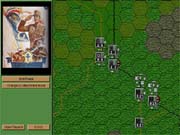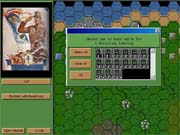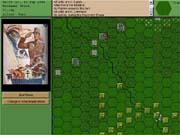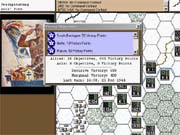Last summer, the release of the innovative Combat Mission: Beyond Overlord was a major event in computer wargaming. However, outside the realm of tactical games (in which units represent single vehicles and small groups of men) there really hasn't been much deviation from the formula that has served wargamers for the past 20 years: a hex-based system derived from the traditional tabletop wargames that were most popular in the 1970s. Combat Command 2 sticks closely to this tried-and-true formula, but manages to seem like more than just another board-game port.

Combat Command 2 doesn't try to do anything revolutionary. Instead, it concentrates on taking the fundamentals of wargaming and making them easy to manipulate in a computer game. The game doesn't really introduce any new concepts, but it features the strategic decision making of a wargame without so many details that the game becomes an unplayable mess. Thus, Combat Command 2 avoids the needless complexity that plagues many computer wargames.
The game also eschews fancy graphics and sound, to the point where those unfamiliar with the standards of wargames might think that Combat Command 2 is 5 or more years old. The unit graphics aren't actually bad as far as wargames go; they are clean and functional, though the terrain is ugly and can sometimes be difficult on the eyes. The sound isn't especially bad either; there just isn't much of it other than perfunctory gunfire and vehicle sounds that do little more than alert you to the fact that something is happening. Anyone who expects aesthetic gratification from computer games should probably pass on Combat Command 2.

Otherwise, Combat Command 2 features a robust gameplay system that concentrates on the difficulties inherent in commanding large numbers of military units in combat. The gameplay is turn-based, and it will be immediately familiar to anyone who has ever played a tabletop wargame. The game's scale is 500 meters per hex with turns the represent four real-world hours (six hours at night) and units of company size. Each of the more than 20 scenarios focuses on a battle or part of a battle and typically lasts several historical days. The scenarios tend to be Mediterranean or Western Front battles with an emphasis on amphibious landings and paratroopers. Units include American, British, Italian, and German troops, and battles range from small conflicts like the one for the Heraklion airfield in Crete, to a small portion of the Battle of the Bulge around Bastogne. Small-scale scenarios can be completed in an evening, while playing a larger battle might take several days. The game also features extensive rules for paradrops, glider landings, minefields, night combat, and all the features you'd expect from a World War II game.
As its name implies, Combat Command 2 focuses on the problems of actually commanding troops on the battlefield and thus includes a detailed command system that rewards you for keeping formations intact instead of just spreading units around to get the optimal mix of combat factors. The printed manual spells out all the game mechanics clearly and includes all the charts and tables used in the game. There are no mystery calculations, and unlike The Operational Art of War series, Combat Command 2 doesn't feature an excessive number of overly complex calculations. The game displays the projected combat results table for each combat (dynamically, as you select units) so that you can quickly see your chances for success.
Playing the game involves quite a bit of clicking, but because of the redundancy of the interface (unit modes can be assigned either by clicking an onscreen button or by right-clicking the mouse, for instance) the game plays significantly more smoothly than most similar computer wargames. The game conveniently lets you display different vital information on the units themselves simply by pressing the Tab key to cycle though a unit's statistics. Multiple zoom levels also help you keep track of the battle. When you click on a unit, it's easy to see where it can move and how many movement points it takes to get there. The only problem is that it's easy to accidentally move a unit instead of deselecting it, although as you get used to the game, this becomes less of a problem.

Unfortunately, the artificial intelligence in Combat Command 2 is plagued by the same problems that appear in virtually all wargames. Specifically, while the AI can manage individual units acceptably and its tactics aren't bad, it has a hard time coordinating large attacks and sometimes acts as if it can't see the forest for the trees. As with other wargames, these deficiencies are less evident when the AI is on the defensive.
Regardless of the game's AI, Combat Command 2's solo scenarios are enjoyable enough. There is enough variety in the scenarios to give you a range of possibilities, including attacking as either the Axis or the Allies. To this end, there's a hypothetical Sealion scenario (the invasion of England), which gives the Germans a chance to drop paratroops, make amphibious assaults, and attempt air landings.
However, Combat Command 2 was clearly designed with play-by-e-mail (PBEM) play in mind, and it's most enjoyable when played in this manner. The computer can be told to handle up to four different phases by itself, including direct fire, assault defense, withdrawals, and advances, and assigning these functions to the computer lets you proceed at a pace of one mailing per player-turn. You can also take control of individual phases yourself, although the game has a bug that won't let you end your turn if you're using manual withdrawals but have no withdrawing to do. As such, PBEM games should be played with computer-controlled withdrawals until a patch is produced. The AI decisions in these phases are reasonable, and they won't hurt your chances of victory. The game even notifies your opponent if you reload a previously loaded turn, which helps reduce the cheating that sometimes occurs in PBEM games. The replay feature provides all the information you need from your opponent's turn, and does so quickly, so there's little delay.

The game also includes a scenario editor that lets you create other historical battles on a similar scale, and the exchange of user-made scenarios is often what gives wargames like this extended life. While would-be designers are currently limited to the terrain and unit mix in the game (and thus can't create Eastern Front or North African scenarios, because there are no Russians or desert terrain), Shrapnel Games has plans to extend this same system to other theaters of war.
Combat Command 2 also fills a niche between purely tactical games like Combat Mission and operational games like John Tiller's Panzer Campaigns series that depict entire campaigns on a larger scale. There hasn't been a good World War II game that portrays battles of this scale since the venerable V for Victory series. Combat Command 2 is only available by direct order through the Shrapnel Games Web site at www.shrapnelgames.com. The game comes without a box, with the CD in a paper sleeve, shrink-wrapped inside the manual. Despite its no-frills appearance, the game features enough substantial gameplay to more than justify its $39.95 price tag. While it probably won't appeal to anyone other than historical wargamers, these players will find Combat Command 2 a satisfying experience.